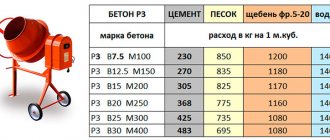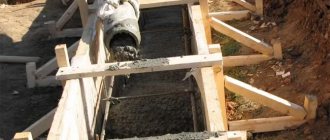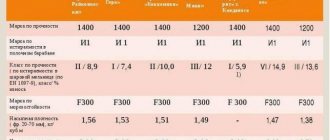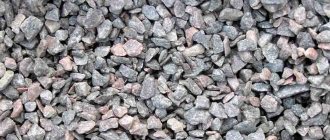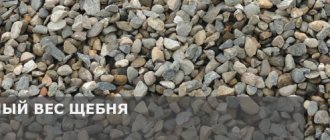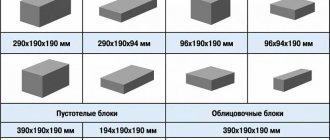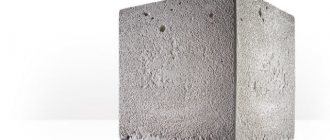Very often, developers have a question about what 1 cube of concrete represents - how many liters of solution fit in a given volume. Even some experts do not know the correct answer to this question, although everything is quite simple, and after reading this article, you will be convinced that carrying out calculations is quite possible even for those who have never encountered such work. Knowing the basic indicators of the ratio of weight and volume, you can very quickly and accurately determine all the necessary values.
All construction organizations count concrete in cubic meters, which is why this measurement method is applicable for all work of this kind
What does it consist of?
A big advantage will be the ability to vary the composition of concrete depending on the goals. This will also help you save on more expensive components, and at the same time use building materials very rationally.
Now there is not a single industry where concrete products are found. Road surfaces, residential and industrial buildings, as well as hydraulic structures, bank protection and even most block materials for construction are made using various types of concrete.
What is the specific gravity of crushed stone 40 70, you can find out from the article.
Ready-made concrete solutions can be purchased, as they say locally, at the nearest construction company and you can only be confused by the question of how much cement is needed per cubic meter of concrete. For large-scale work, the best solution would be to rent special equipment, but for home alterations and repairs, you can limit yourself to purchasing a mobile concrete mixer of a given volume. Such a device will significantly facilitate labor-intensive work and improve the quality of the finished mixture due to uniform mixing.
The composition of purchased solutions is regulated by state standards, so here, to a large extent, everything depends on the integrity of the manufacturer. It will be difficult to independently check the quality of the finished mixture, so you should not blindly trust the best offers.
What is the bulk density of crushed stone 20 40, you can find out from this article.
For home construction, a clear ratio of proportions is not required, so you can use the table below to quickly and without difficult calculations obtain a ready-made concrete mixture of the given parameters.
Ingredient ratios in concrete mortar:
| No.: | Concrete grade: | Cement grade: | Quantity of cement: | Sand, kg: | Crushed stone, kg: | Water, l: |
| 1. | M 50 | M 400 | 380 kg (1.0). | 645 kg (1.69). | Gravel 608 kg (1.59). | 210 l (0.55). |
| 2. | M 75 | M 300 | 175 kg (1.0). | 945 kg (5.4). | 1053 kg (6.02). | 210 l (1.2). |
| 3. | M 100 | M 300 | 214 kg (1.0). | 870 kg (4.07). | 1080 kg (5.05). | 210 l (0.98). |
| 4. | M 150 | M 400 | 235 kg (1.0). | 855 kg (3.64). | 1080 kg (4.6). | 210 l (0.89). |
| 5. | M 200 | M 400 | 286 kg (1.0). | 795 kg (2.78). | 1080 kg (3.78). | 210 l (0.74). |
| 6. | M 250 | M 400 | 332 kg (1.0). | 750 kg (2.26). | 1080 kg (3.25). | 215 l (0.65). |
| 7. | M 300 | M 400 | 382 kg (1.0). | 705 kg (1.85). | 1080 kg (2.83). | 220 l (0.58). |
| 8. | M 350 | M 400 | 428 kg (1.0). | 660 kg (1.54). | 1080 kg (2.5). | 220 l (0.51). |
How many buckets of cement are in a 50 kg bag?
Some builders use 10 or 12 liter buckets as a unit for measuring the amount of cement. That is why the question arises, how many buckets of cement are in a standard bag weighing 50 kg.
However, before making calculations according to this question, it is necessary to take into account the concept of specific density of cement in the form of a fill. This indicator depends on the characteristics of storage, duration of transportation and compliance with production rules. The average mass of bulk cement is 1200 kg/m 3, and the density of the product, which has been stored for a long period, is 1600 kg. Therefore, the average specific gravity is about 1300 kg.
Next, for calculations, we need to decide on the volume of the bucket (10 or 12 liters).
If you use a 10 liter bucket, then its volume will be 0.01 m 3 based on the fact that 1 liter = 1 cubic decimeter. If we take into account the average density of cement of 1300 kg/m 3, then approximately 13 kg will fit in a 10 liter bucket. It turns out that 3.85 buckets fit in one bag of cement.
If you use a 12 liter bucket, then its volume is 0.012 cubic meters. One such bucket holds 15.6 kg of cement. It turns out that there are 3.2 12-liter buckets of cement per bag.
Please note that these calculations are not extremely accurate. It is recommended to use a bag as a unit of measurement.
Calculation of components for one batch in a concrete mixer
1. Determine the yield coefficient of the concrete mixture:
2. Determine the consumption of concrete mixture components for one batch
- Cement for one batch = (Vb*β/1000)*C
- Water for one batch = (Vb*β/1000)*V
- Sand for one batch = (Vb*β/1000)*P
- Crushed stone for one batch = (Vb*β/1000)*Sh
where C, V, P, Shch is the consumption of materials per 1 m3 of concrete.
This calculation can be used to calculate the components of a concrete mixture for any vertical loading container (trough, mason's box) into which you will mix the mixture.
For the actual calculation in the concrete mixer, the mixture yield coefficient from the concrete mixer was taken equal to 0.44. To calculate the coefficient, a sample was compiled based on the responses of people from different construction forums who made batches with their own concrete mixers with different working volumes. © www.gvozdem.ru
If your mixture is too stiff, you can go in two ways to make it more flexible:
- adding a plasticizer;
- adding water and cement in the calculated W/C ratio.
Concrete hardening speed. Dependence on time and temperature - table
GOSTs, books, programs and calculators for calculating the composition of concrete
Cubic meter - Wikipedia
| Cubic meter | |
| m3, cubic m. (m3) | |
| Cubic meter | |
| Magnitude | volume |
| System | non-systemic |
| Type | derivative |
Cubic meter
(cubic meter) is a unit of volume derived in the International System of Units (SI), as well as in the MKGSS and MTS units systems.
A cubic meter is equal to the volume of a cube with the length of each edge equal to 1 meter[1].
Content
- 1 Term
- 2 Measurement
- 3 Facts
- 4 See also
- 5 Notes
- 6 Links
Cubic meter of concrete The term and its abbreviations are derived from the words cube and meter. In the absence of technical capabilities
how many liters in a cube of concrete - How much does 1 liter of concrete weigh, very necessary!!! — 2 answers
In the Technology section, the question How much does 1 liter of concrete weigh is very necessary!!! given by the author *Nyutik* the best answer is this: In order to make one cube of concrete you need to spend: one hundred and fifty liters of water, two hundred and eighty kilograms of cement, seven hundred kilograms of crushed stone and sand you will need - 1,175 kilograms. One cube of concrete weighs from 250 kilograms to 5 tons, it depends on the components of the concrete and on the construction tasks. There are 1000 liters in 1 cubic meter, so count it. The weight of a cube of ordinary concrete is on average 1900 - 2500 kg, which means a liter is 1.9 - 2.5 kg.
Answer from ScrAll [guru] From 2.7 to 3.1 kg Answer from Mikhail Fomichev [guru] Concrete can be different, light and heavy.
From 0.5 kg to 2.5 kg.
Answer from Mr.Androws[guru]The fact is that concrete can be in different states: fresh (just mixed), at the drying stage and dried in a heat chamber. Therefore, the specific gravity of each state will be different. Answer from Alexander, 36 years old [active] You will take physics in the 7th grade. Answer from Denis Khaustov [newbie] I don’t know how much its mass is —————-1 liter Answer from Mikhail Orekhov [ newbie] about 1.4 kg Answer from Olga xD [newbie] How much - 1 liter!! and it weighs! Answer from Eenat Latypov [guru] Who do you want to wall up?)) Answer from Natalya Ushakova [newbie] For heavy concrete M200 - M400, take 2.2-2.3 t/m3. You can't go wrong. Answer from DEMON[guru] fucking stupid people!! a man asked about the weight of one liter of concrete. downs. This is necessary to select a concrete mixer, for example.
2oa.ru
Proportions of components in solution
The standard ratio of proportions of components for pouring a foundation is 1: 3: 5 (cement - sand - crushed stone). But that’s not all - in order for the solution to be of high quality, one should take into account the activity of Portland cement, the volume and weight of all components, the time of the beginning of setting and the end of hardening of the solution, to determine the grade - the mobility of the mixture, the characteristics of water separation in the solution, density and water resistance, and for reinforced concrete structures - voids of the solution, fractions of fillers, volume, humidity and weight of all components, composition and volume of organic substances, density of lamellar and needle-shaped filler granules.
| Components | Cement | Sand | Crushed stone | Water |
| Concrete M 200 – M 300 | 1 x 50kg bag | 8 x 10 liter buckets | 12 x 10 liter buckets | 3 10 liter buckets |
| 1 m 3 | 6 units | 48 units | 74 units | 20 units |
| Masonry mortar | 1 x 50kg bag | 16 x 10 liter buckets | — | 4 10 liter buckets |
| 1 m 3 | 6 units | 96 units | — | 23 units |
| Plaster mixture | 1 x 50kg bag | 13 x 10 liter | — | 3 10 liter buckets |
| 1 m 3 | 7 units | 91 units | — | 24 units |
Proportions in buckets
Technical and operational characteristics and brand of building material are determined by the ratio of the proportions of the components per cubic meter of concrete, and depend on:
- The composition of cement - weight, activity of the substance, beginning and end of cement setting;
- Dependencies of proportions in a cube of concrete - volumetric weight, strength, mobility and water resistance;
- In sand - voids and fraction of the material, weight and volume of sand, humidity and clay content;
- In aggregates - volumetric mass, voidness, strength and humidity, degree of contamination.
| Concrete | Cement | Water-cement ratio | Filler size, mm | Water, liters per m 3 | Cement, kg per m 3 | Sand, tons per m 3 | Aggregate (gravel, crushed stone), tons per m 3 |
| M 100 | M З00 | 0,75 | Gravel 10 mm | 205 | 273 | 1,092 | 1,092 |
| 0,8 | Crushed stone 10 mm | 220 | 275 | 1,1 | 1,1 | ||
| 0,75 | Gravel 20 mm | 190 | 253 | 1,012 | 1,012 | ||
| 0,8 | Crushed stone 20 mm | 205 | 256 | 1,024 | 1,024 | ||
| M 200 | M 400 | 0,63 | Gravel 10 mm | 205 | 325 | 1,3 | 1,3 |
| 0,68 | Crushed stone 10 mm | 220 | 324 | 1,296 | 1,296 | ||
| 0,63 | Gravel 20 mm | 190 | 302 | 1,208 | 1,208 | ||
| 0,68 | Crushed stone 20 mm | 205 | 302 | 1,208 | 1,208 | ||
| M 250 | M 500 | 0,64 | Gravel 10 mm | 205 | 320 | 1,28 | 1,28 |
| 0,69 | Crushed stone 10 mm | 220 | 319 | 1,276 | 1,276 | ||
| 0,64 | Gravel 20 mm | 190 | 297 | 1,188 | 1,188 | ||
| 0,69 | Crushed stone 20 mm | 205 | 297 | 1,188 | 1,188 |
If the solution is formulated and mixed correctly, the concrete will be of high quality, and when it sets and hardens, its strength will be equal to the declared one, and will increase over time.
Water cement ratio
Criteria for proper preparation of concrete
In the photo: only laboratory tests can accurately determine the grade of concrete
During the work process, it is important not only to correctly calculate the amount of solution, but also to ensure that the resulting concrete meets the required parameters. Calculation of how many materials are in 1 cube of concrete is made depending on the desired brand. If you do both the calculations and concreting yourself, then you will need instructions for the correct selection of each component.
Components
The quality of the compositions used directly affects how much material is needed per 1 cubic meter of concrete, so remember a few important recommendations:
- The choice of cement is one of the fundamental stages of the entire preparatory process. The higher the grade of the composition, the less of it is needed to achieve the required strength and the better the quality of the composition. The ideal option is M500 without any additives, but it should be remembered that long-term storage of cement reduces its characteristics, so it is better to purchase it immediately before starting work and store it in a dry place.
Cement is the main component in any concrete, it is it that determines the grade of the composition, so its proportion must be monitored very carefully
- Sand serves as a filler that improves the adhesion of the components to each other. In addition, it makes the solution more uniform and plastic and facilitates the process of preparing concrete. It is important that the sand be coarse-grained without any impurities (clay is especially harmful - it reduces the grade of the resulting composition and causes a significant waste of cement).
- Crushed stone is the main inert filler, on which the strength and durability of manufactured structures largely depends; the best material is made from hard rocks with a fraction of no more than 40 mm. It is important that the crushed stone does not contain black soil, clay and other contaminants, otherwise it must be washed with running water before use.
- Water is the last of the irreplaceable components; it is its reaction with cement that triggers the processes due to which concrete turns into stone and maintains the high strength of concrete products for decades, or even centuries. The requirements for water are quite simple: it must be clean, free of debris and foreign impurities; silt and clay are especially undesirable.
Lack of water, as well as excess, negatively affects the quality and strength of concrete structures
Important! To improve frost resistance properties and make it resistant to moisture, various additives can be mixed into concrete. When choosing one option or another, it is better to choose products from well-known manufacturers, this guarantees the quality and effectiveness of the solution.
Solution composition ratio
As noted above, the volume of the composition is always the same regardless of the brand, now let’s figure out how many kilograms are in a cube of concrete. This indicator mainly depends on the brand of concrete, since the components have different weights, and a change in their ratio in the composition causes significant fluctuations in mass.
Let's consider how many kg are in a cube of concrete of the most popular and sought-after brands. For greater clarity, we present the information in table form:
| M100 | From 2,450 to 2,550 |
| M200 | From 2,380 to 2,480 |
| M300 | From 2,330 to 2,430 |
| M400 | From 2,310 to 2,410 |
It’s easy to figure out how many tons are in a cube of concrete; if you take the arithmetic average, the most often used figure is 2.4 tons. Even if you did not have the opportunity to observe the process of preparing the solution, you can weigh the composition - if its weight is close to the average, it means that the composition meets all reliability requirements and is suitable both for pouring concrete screeds and for constructing any type of foundation.
Important! The consistency of concrete can also tell a lot about the quality: it should be quite plastic. At the same time, it is normal to keep its shape: when stirring with a shovel, the solution should not stick to the bayonet - this indicates too much water. In this case, you should add either a little cement or cement with sand.
Consistency will also say a lot about the quality of the composition.
We have figured out how much concrete is in 1 cube, now we need to consider in what proportions this or that component is contained in the composition. Experts who are constantly involved in concrete work advise measuring the proportions as follows: take cement by weight, since it is packaged in bags of 50 or 25 kilograms, and it is easier to add it directly from them, rather than pouring it into any container.
The bucket allows you to measure the exact proportion of each of the necessary components
As for other components, it is more convenient to measure them in liters and use ordinary buckets for this, since using larger containers is quite difficult - they will weigh very, very much.
Experienced builders, who have become skilled at dosing components, even use a shovel - with its help, the work is carried out even faster, but it is important to very carefully monitor the quantity of each part in order to avoid violations, because this will lead to a weakening of the solution.
You can get by with just a shovel, but you will still need a bucket for water
Let's look at the ratio of parts using the example of the most popular and sought-after brand M200 using M500 cement:
- 275 kilograms of cement is either 5 and a half bags of 50 kg or 11 bags of 25 kg.
- You will need 520 liters of sand, that’s 52 10-liter buckets.
- Crushed stone requires 870 liters, that is, 87 buckets.
- At normal humidity of all the above components of water, you will need 180 liters , but the exact value is determined based on the consistency of the solution; if necessary, the amount of water is reduced or increased.
Concrete M200 is used for most foundations in private buildings
So, we figured out how many buckets there are in a cube of concrete - if you use a container with a capacity of 10 liters, then exactly 100 buckets will make up a cube of mortar.
You can make concrete yourself, or you can order it ready-made. Naturally, the price of this option is slightly higher, but you get rid of a lot of work and save a lot of time.
Weight of 1m3 sand concrete mortar
The specific gravity measurements used are as follows:
- 2.4 g/cm3;
- 2.4 t/m3;
- 2400 kg/m3.
In order to reduce the consumption of sand concrete, it is recommended to use products intended for screeds - expanded clay, granite chips. It is not uncommon for screeds to have filling substances that make up up to 60 percent of the total volume.
Depending on the components of the mixture, there are such common brands of sand cement - M 150, M 200, M 300, M 400. The most popular material is the M 300 brand, moreover, this mixture has excellent technical features and reasonable cost.


